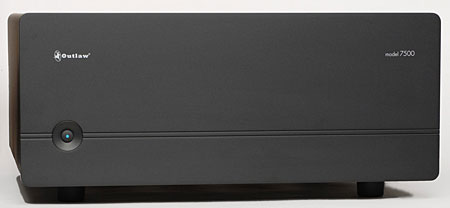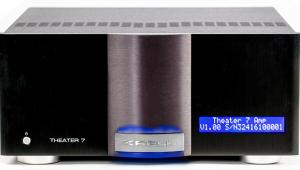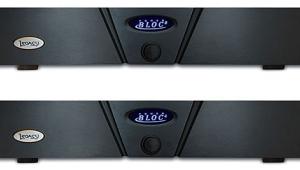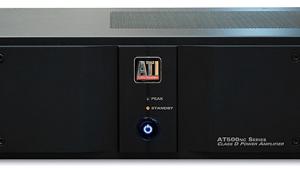Outlaw Audio 7500 5-Channel Power Amplifier

Outlaw Audio, an online seller of power amps, preamp/processors, A/V receivers, speakers, and subwoofers, offers the Model 7500 5-channel power amp among others. It's a heavy, beefy amplifier with high-performance features and impressive specs at a down-to-earth price. Does it deliver the goods? Let's find out...
Features
The Outlaw 7500 utilizes dual toroidal power supplies with multiple windings for each channel, and it's spec'd to deliver 200 watts to each of five channels driven simultaneously into 8 ohms. This is an important specification—many amps are measured while driving only one channel, which doesn't reveal their true performance while reproducing demanding multichannel music and home-theater sources.
The 7500 employs a differential circuit design. Simply stated, a differential amplifier employs a technique called common-mode rejection, which reduces crosstalk between channels and improves transient signal response. The Outlaw 7500 has a crosstalk specification of -100dB between channels, which is very good.
Slew rate is another important specification, often overlooked in spec sheets. This is a measure of how fast the amp can increase the output voltage, and it portends rapid transient response. The slew rate of the Outlaw 7500 is 50 volts/microsecond, a very respectable specification.
Yet another important spec is called damping factor, which is the ratio of the speaker's input impedance (its resistance to electric current from the amp) and the amp's output impedance. The higher this ratio—that is, the lower the amp's output impedance—the better the amp can control the speaker's movement and overcome the inertia of the diaphragm's motion. Of course, this depends in part on the speakers you use with the amp. The 7500 has a damping factor greater than 400 from 10Hz to 400Hz when connected to a speaker with a nominal impedance in the range of 4-8 ohms, which is another excellent spec.
The 7500 features fully balanced circuits with XLR inputs as well as unbalanced RCA inputs. The benefit of balanced inputs is improved noise rejection from external sources, especially if you have long cable runs between the preamp and amp. These should be used whenever possible.
In order to conserve power, the 7500 is equipped with a 12-volt trigger, which lets a pre/pro activate it when needed.
There are no cooling fans in this amp. Its large heat sinks and chassis construction are designed to draw heat away from the critical circuitry without the need for fans, which can create a noisy distraction in a home-theater environment.
As many enthusiasts know, specifications are just static measurements of a component's performance and don't tell the whole story. The true test is its performance with real-world material.
Several years ago while attending a new-product demonstration, I challenged the presenter with his competitor's spec sheet that had much better printed specifications. He responded calmly by holding his product's spec sheet to one ear and the spec sheet from his competitor's product to his other ear and asked me, "I can't hear the difference, can you?"
Point taken! The Outlaw 7500 has high-performance specs, but what about its sonic qualities? How well does it perform while driving multiple speakers with dynamic source material?





























































